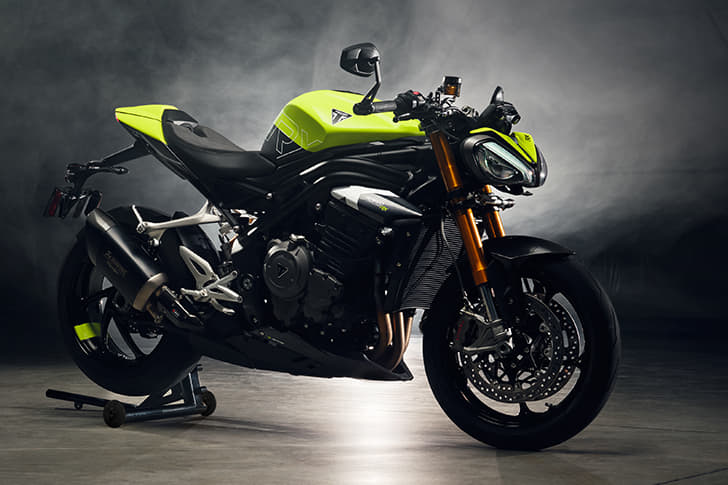We rode the biggest of the Tiger siblings not long ago and discovered that Triumph has stepped up its flagship by a fair extent. But that ride happened in a mildly chilly part of Spain, governed only by a 140kph speed limit on the highway and by how courageous one felt off the road, with an ambulance and refreshments on standby. In India, we had no such luxuries at our disposal – just man and machine, and somewhere to go. This is the more realistic review, then.
Let’s start with stating the obvious – this is a very large motorcycle. The XCX is the only variant of the Tiger 1200 you can buy in India (the range-topper is the XCA) and it can dwarf a decently sized motorcycle such as a Royal Enfield Thunderbird with nonchalance. At first impression, it looks like a motorcycle you’d rather admire, parked. But there is a reason why it looks the way it does; this is Triumph’s version of a two-wheeled passport. On it, you can cross continents and not even realise it. It’s a sophisticated touring motorcycle with enduro capabilities, which makes it a rare and extremely desirable breed.

So, with the riding mode set to ‘sport’ and the windscreen lowered (electronically, via a toggle switch on the LHS control pod), I set off, only to be instantly swamped by a sea of crawling traffic. Understandably, this isn’t the best place to reacquaint oneself with a motorcycle, especially not with one this humongous, but it didn’t seem as difficult as I had thought either. The wide handlebar, set at a comfortable height, offered terrific leverage even at walking speeds and the commanding riding geometry meant I felt in control, with a great view (of tail-lamps, mostly) to boot.
Once you come to terms with the dimensions (the width, as much as the height) of the Tiger 1200, the 265kg weight isn’t a hindrance on the go. Despite being seated 835mm off the ground, at which point you are at eye-level with SUV drivers, it’s quite easy to manage the Tiger through traffic. The brakes are on point as well, with a (305mm) twin-disc setup at the front and a (282mm) single disc at the rear. Thanks to the Triumph Semi Active Suspension (TSAS), I didn’t have to bother with any suspension settings once I’d picked the riding mode of my choice (out of six in all – Road, Rain, Sport, Off-road, Off-road Pro and the fully-customisable Rider). Ride quality is great once the suspension gets used to a particular road surface, but transitioning surfaces can take it by surprise occasionally and it responds with a firm feel. All things combined, the Tiger 1200 XCX felt natural in traffic, although to say it stood out a fair bit and made jaws drop would be an understatement.

About half an hour later, all was not so well. As I painfully discovered, the 1200’s fuel tank (particularly the bit towards the rider’s seat, which you are meant to grip) gets unbearably hot in not much time. This happens primarily in city traffic and also out on the highway, and it’s not something you can afford to overlook if you intend to be a regular user. A week of everyday use (over a mixed cycle) later, I have heat scars to show (although I doubt that’s something you want to see) and that’s not among the nicest things done to me by a motorcycle. It didn’t get worse than that, which is a small mercy, but it was uncomfortable enough to demand pulling over, which is not what you want from a motorcycle you are meant to ride around the world.
Thankfully, the Tiger 1200 XCX has other qualities that help you move on. Primary among them is the enormously powerful powerplant – a 1,215cc, four-valves-per-cylinder, liquid-cooled engine that produces 141hp at 9,350rpm and 122Nm of torque at 7,600rpm. Transmission is via a six-speed unit and the gearshift pedal is well-suited to even motocross-grade boots (although it was a tight fit for me, given that I wear size 12s; riders with smaller feet shouldn’t face any issues). The motor, at its perkiest in Sport mode, is amply equipped to provide big-bike thrills on the road. Aggressive riding presents you with easily controllable wheelies and the triple emits a distinct roar, courtesy of the factory-option Arrow exhaust system. Tractability, too, is absolutely brilliant, with the 1200 being able to potter around in sixth gear at even unrealistically low speeds such as 40 kph. Best of all, it makes light work of munching highway miles, coming across as supremely comfortable at sustained high speeds. The downside is that this motor isn’t quite as refined as the Tiger 800 and there are minor vibrations that creep in at both low and high revs, but the mid-range stays smooth throughout.

The tyres – a 19-/17-inch (front/rear) combination – sit on wire-spoke wheels with aluminium rims, and feature an off-road-biased tread, which thankfully doesn’t take too much away from the Tiger’s road-holding abilities. In isolation, it suffices as the only kind of bike you’ll ever need, although its peers do have a few aces up their sleeves too. The Ducati Multistrada 1200 (the 1260 is due for an Indian launch soon) is far racier on the road, while the BMW R1200GS is contrastingly (but gorgeously) refined; the Tiger ventures near neither extreme, in comparison.
Off the road is where the Tiger 1200 XCX really shines. The day I’d picked for venturing into a fast but tricky trail turned out to be a rainy one. With precarious patches of slush lining the road, it wasn’t most ideal for what is the antithesis of a light, flickable dirt bike. Drawing from my earlier experience with the Tiger 1200, I switched to Off-road Pro mode, which disengages traction control and rear-wheel ABS, among other finer adjustments. In this mode, it’s closest to being a pure enduro machine and its transformation is almost unbelievable. You can stand up on the pegs and ride it at very low speeds as you scan the terrain, or blast through undulations without a care in the world – the Tiger 1200 takes everything in its stride, leaving you to concentrate on the basic controls. It’s stupendously supple off the road – although the Honda Africa Twin (though not exactly comparable) is untouchable in this aspect – and there is good feedback from every element, just as you’d need. As long as you can manage to not get the front tyre caked with slush (a bad thing on any motorcycle), or if you aren’t tackling a treacherous slow-speed rock bed (you need one leg on the ground and strong forearms), the Tiger is as easy to ride off-road as it is on the open highway.

The 1200 XCX is also very feature rich, which means you can show off with it even if you’re just out for a short spin in the city. The lights at either end are LED units and it (along with the XCA) also gets adaptive cornering lights, an adjustable full-colour TFT screen, illuminated switchgear, cornering ABS, keyless ignition, cruise control, heated grips and a heated seat as well. It doesn’t, however, get Hill Hold Control (XCA only), Integrated Braking System (XRT, XCA). Shift Assist, which is Triumph’s take on the quickshifter is available as an accessory on the XCX but is standard only on the XRT and the XCA. In addition, it also gets a two-position seat height adjustment (835/855mm), USB and 12V power sockets. The only thing Triumph has left out for understandable reasons is the kitchen sink, and you shouldn’t be complaining about it. The Tiger 1200 uses an IMU to aid its electronic assists, but the traction control system still needs improvement and isn’t as smooth and clever as we’d like.
Is this genuinely an expedition motorcycle like it says on the cover? Yes, it is, down to every detail. Is it one you should buy, however? Look at it this way – it’s not as potent off the road as an Africa Twin, not as sporty as a Multistrada and certainly not as legendary and ice-cool as the R1200 GS, quite literally when you consider the tank’s tendency to heat up. On the good side, the Tiger 1200 is backed up by Triumph India’s relatively strong sales and service network, offers easy-to-meticulously-tailored rider assists and is a motorcycle that’s guaranteed to turn heads in most scenarios south of the Dakar rally. At Rs 17 lakh, the Tiger 1200 XCX is the cheapest of its kind, although it has the iconic BMW R1200 GS Adventure (Standard variant) breathing down its neck at a close Rs 17.10 lakh (both prices, ex-showroom, India).

And then, you have another strong competitor to consider before you sign on the dotted line – the Tiger 800! In the real world, the 800 is as capable, if not more (it is more nimble off the road, for one), and is a smoother, more refined machine overall. It’s also far more affordable, with the most expensive of the Indian range, XCX costing Rs 13.76 lakh (ex-showroom, India). The only reason you’ll really want a 1200 over an 800 is for its electronic suspension and its ability to average higher speeds on the highway, the last of which matters in the west, but less so on Indian highways. All things considered, you stand to win either way – just ensure you’ve got enough blank pages left in your passport!















































